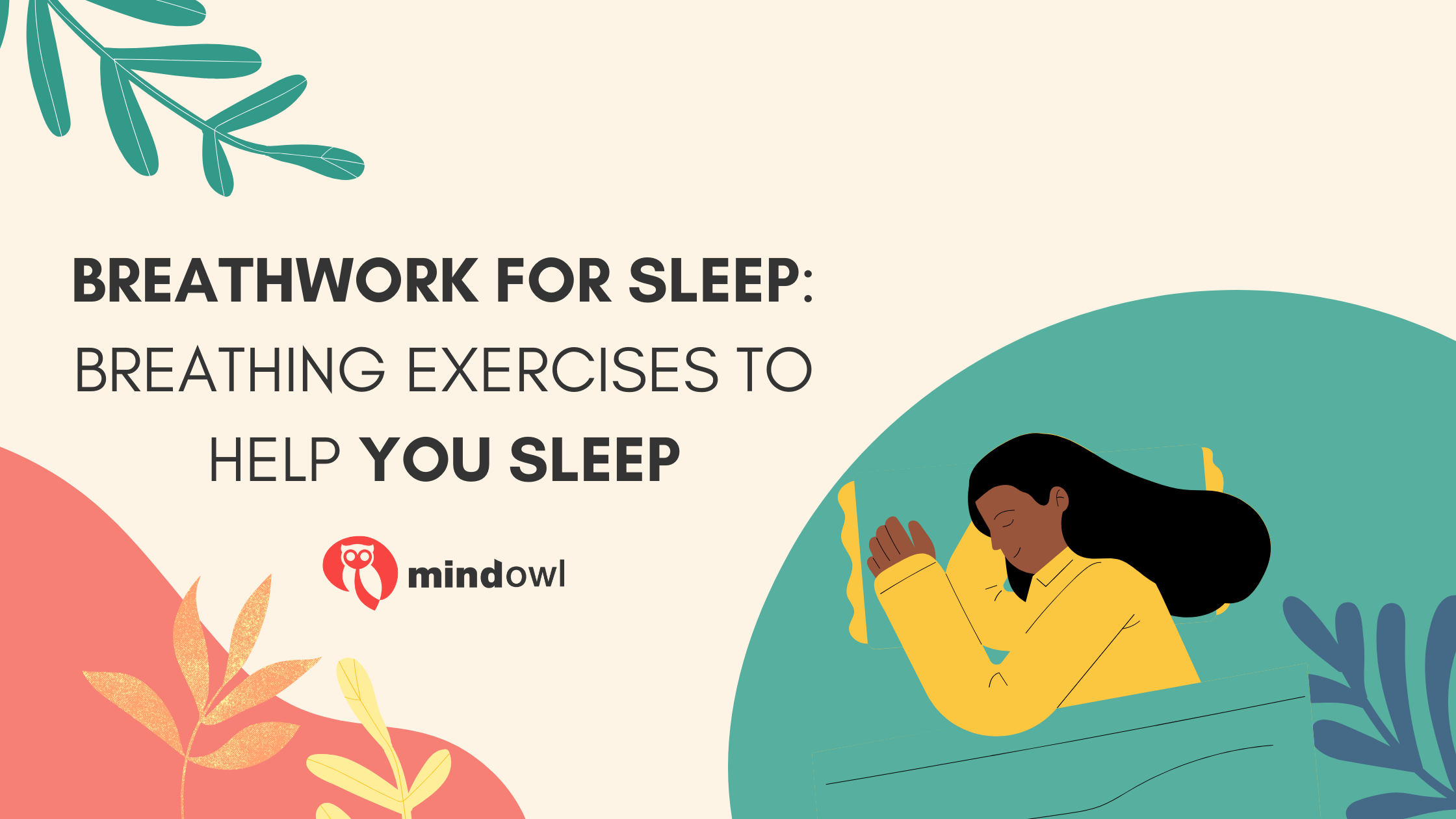Breathwork for sleep: can breathing exercises help you to sleep better?
Many of us will struggle to transition to sleep at night because we try to go to bed with our minds still active from the day. This can result in struggles sleeping, stress and anxiety. So what should we do before bed to get our minds and bodies prepared for sleep? Among the well-known sleep hygiene list of tips like avoiding screens for an hour before bed, and cutting caffeine out of our evening routine, there are more effective steps that we can take. In this article, we are going to be discussing the importance of breathing exercises as a method of preparing ourselves for sleep.
Moving through this article we are going to detail a few techniques that you can test out before bed in order to achieve a more peaceful and relaxed sleep. So, let’s begin by discussing exactly what breathwork is and how it can be a powerful tool against stress.

What are breathing exercises?
Breathing exercises are designed to take advantage of the strong link between body and mind. You will probably be aware that when you feel anxiety or stress your breath will come in short, shallow inhales and exhales. This physical reaction to an emotional state creates a cycle between bodily sensations and the mental experience of negative emotions. By using breathing exercises we can hack this system and create a calmer emotional state that will help us drift into sleep.
Breathing exercises can do one of three things: calm us down, energise us, or balance us. The exercises discussed in today’s article will have the purpose of calming you down, however, if you are interested in finding out more about the other techniques then we have already written an article that goes into depth on this subject. You can explore that article here, https://mindowl.org/how-breathwork-can-supercharge-your-meditation-practice/
Breathwork for sleep: Exercises your can try before going to bed
4-7-8 Breathing
The first technique we are going to be discussing is Dr Andrew Weil’s 4-7-8 breathing technique. This is a similar technique to box breathing, where you will breathe in a structured sequence. So, breathe in for four seconds, hold the breath for seven seconds, and then exhale for eight seconds. It may seem counterintuitive, but exercises that require you to hold in breath for an extended amount of time will actually increase the oxygen level in your body. This allows your muscles to relax, and for your mind to calm and slow down.
So, that’s the brief overview of the practice, here are a few more tips on how to make this practice work for you:
- If you are trying to fall asleep, lie down flat. Otherwise, sit in a comfortable position with good posture.
- Empty you lungs by exhaling through your mouth and making a whooshing sound.
- Next, close your mouth and inhale through your nose for four seconds.
- Hold your breath in for seven seconds.
- Exhale through your mouth for eight seconds, again making a whooshing sound until all the air has left your lungs.
- Start the cycle again.
When you are using this practice you can start by doing four rounds of breaths. After you have become more comfortable with the practice you can build up to six or eight rounds of breaths, and feel the effects of deep relaxation that follow.
Abdominal Breathing
You may have noticed that any time you feel stressed, anxious, or frightened that your breathing will come from your chest. As you breathe you will notice that it is your chest that is rising and falling, and that your inhales are shallow and short. This type of breathing is linked with our fight or flight reaction as it is our bodies way of preparing to either fight off a threat or run from a threat. Despite this being a very useful reaction for our ancestors who might have come across a wild animal or rival tribe on a daily basis, when we are trying to go about our daily life or fall asleep, this is not a useful way to breathe.
Abdominal or deep breathing helps to alter this breathing technique so that we are breathing deeply and fully from our abdomen and not from our chest. If you are unsure of where your breath is coming from, you can place a hand on your chest and a hand on your abdomen and wait to feel which one is moving in time with your breathing. Of course, for abdominal breathing ( also known as diaphragmatic breathing) we are looking for your abdomen to be rising and falling. This will encourage relaxation in our minds and bodies, and help us to drift off to sleep much easier.
How do you practise?
Any method mentioned above can be brought into your daily practice, all you may need to alter is your posture – if you would have been lying down to practise before sleep then you can sit up during the day. We would recommend beginning your practice with a breathing exercise to get you into the right frame of mind for your formal meditation practice.
- Lie flat on your back in a comfortable position.
- Place a hand on your chest and a hand on your abdomen to monitor where your breath is coming from.
- If you notice that your chest is the part that is moving attempt to send your next inhale deep into your lungs.
- Continue this until you feel your abdomen begin to rise and fall in place of your chest.
- Repeat this practice for 5-10 minutes.
When you repeat this practice you should notice your heart rate slowing down, the body’s relaxation response kicking in and your fight or flight reactions subsiding. This is also a practice that you can use during your day-to-day life.
Like any other routine, you need to make sure you are committed to practising regularly in order to build it up as a habit. So try this for a few weeks until it feels like a comforting part of your evening routine. That way, when your mind senses that it is time to do your breathing exercises, then your body will know it is in a comfortable, safe place and knows what to expect.
Breathing Imagery
Breathing imagery is especially useful when it comes to relaxing your mind. In this exercise you do not need to make an effort to change your breathing as such, instead, you will be changing your thoughts in relation to your breathing:
- Lie flat on your back and focus all of your attention on the relaxing feeling of exhalation.
- On each exhale, become aware of your own weight pressing down onto your mattress, and the feeling of your mattress supporting you.
- Become more aware of the sensations in your body and the slowing down of your mind on each exhale.
- Next, try to imagine your exhales as colours. What colours would you see?
This is a very effective way of using the breath to direct your thoughts away from their usual catastrophizing and onto your steady breath.
Other examples of breathing exercises
These are not the only exercises that you can try. There are many, and because we are all different and have different types of sleep disturbances and reasons for our poor sleep then it is only logical that we will all need different breathing techniques to combat this.
Here is a list of other breathing exercises to look into if you are interested:
- Alternate nostril breathing.
- Box breathing.
- Square breathing
- Mindful breathing
- Visualisation
Breathing exercises and meditation
Breathing exercises can be a great addition to your current meditation routine, not only as a tool for improving your sleep. If you are feeling a bit concerned about trying out any of the suggested methods we have mentioned in this article before your go to sleep then it may be a good idea to try them out during your daily life first. The breathing exercises we have covered can leave you feeling a bit tired and sleepy afterwards, so it is best not to try them before an event where you need to be feeling alert.
Conclusion
If this article has convinced you of the wonderful effects of using breathwork for sleep (also known as breathing exercises before bed), then I’m glad! But remember, if the rest of your evening routine involves scrolling on your phone for hours before bed, or late-night caffeine hit then there is only so much that a few deep breaths can do for you. The accumulative effects of everything you do throughout your day and before bed will determine how well you sleep. If it is too overwhelming to start using breathing exercises before bed, to begin with, trial them as part of your everyday meditation routine. This way your mind and body will get used to them and you will be able to trust in their positive effects on your feeling of relaxation before sleep.
MindOwl Founder – My own struggles in life have led me to this path of understanding the human condition. I graduated with a bachelor’s degree in philosophy before completing a master’s degree in psychology at Regent’s University London. I then completed a postgraduate diploma in philosophical counselling before being trained in ACT (Acceptance and commitment therapy).
I’ve spent the last eight years studying the encounter of meditative practices with modern psychology.

